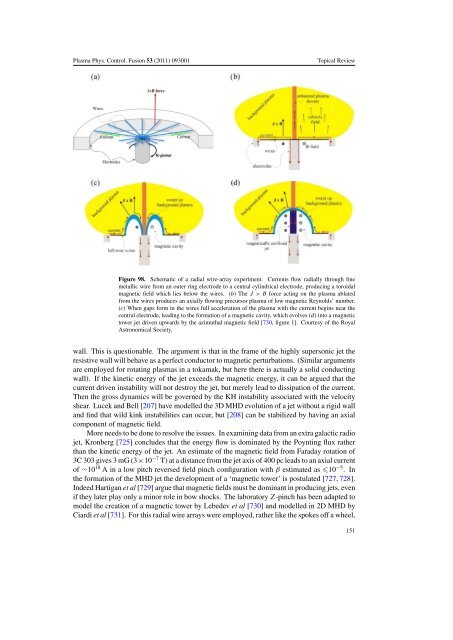Create successful ePaper yourself
Turn your PDF publications into a flip-book with our unique Google optimized e-Paper software.
Plasma Phys. Control. Fusion 53 (2011) 093001<br />
Topical Review<br />
Figure 98. Schematic <strong>of</strong> a radial wire-array experiment. Currents flow radially through fine<br />
metallic wire from an outer ring electrode to a central cylindrical electrode, producing a toroidal<br />
magnetic field which lies below <strong>the</strong> wires. (b) The J × B force acting on <strong>the</strong> plasma ablated<br />
from <strong>the</strong> wires produces an axially flowing precursor plasma <strong>of</strong> low magnetic Reynolds’ number.<br />
(c) When gaps form in <strong>the</strong> wires full acceleration <strong>of</strong> <strong>the</strong> plasma with <strong>the</strong> current begins near <strong>the</strong><br />
central electrode, leading to <strong>the</strong> formation <strong>of</strong> a magnetic cavity, which evolves (d) into a magnetic<br />
tower jet driven upwards by <strong>the</strong> azimuthal magnetic field [730, figure 1]. Courtesy <strong>of</strong> <strong>the</strong> Royal<br />
Astronomical Society.<br />
wall. This is questionable. The argument is that in <strong>the</strong> frame <strong>of</strong> <strong>the</strong> highly supersonic jet <strong>the</strong><br />
resistive wall will behave as a perfect conductor to magnetic perturbations. (Similar arguments<br />
are employed for rotating plasmas in a tokamak, but here <strong>the</strong>re is actually a solid conducting<br />
wall). If <strong>the</strong> kinetic energy <strong>of</strong> <strong>the</strong> jet exceeds <strong>the</strong> magnetic energy, it can be argued that <strong>the</strong><br />
current driven instability will not destroy <strong>the</strong> jet, but merely lead to dissipation <strong>of</strong> <strong>the</strong> current.<br />
Then <strong>the</strong> gross dynamics will be governed by <strong>the</strong> KH instability associated with <strong>the</strong> velocity<br />
shear. Lucek and Bell [207] have modelled <strong>the</strong> 3D MHD evolution <strong>of</strong> a jet without a rigid wall<br />
and find that wild kink instabilities can occur, but [208] can be stabilized by having an axial<br />
component <strong>of</strong> magnetic field.<br />
More needs to be done to resolve <strong>the</strong> issues. In examining data from an extra galactic radio<br />
jet, Kronberg [725] concludes that <strong>the</strong> energy flow is dominated by <strong>the</strong> Poynting flux ra<strong>the</strong>r<br />
than <strong>the</strong> kinetic energy <strong>of</strong> <strong>the</strong> jet. An estimate <strong>of</strong> <strong>the</strong> magnetic field from Faraday rotation <strong>of</strong><br />
3C 303 gives 3 mG (3×10 −7 T) at a distance from <strong>the</strong> jet axis <strong>of</strong> 400 pc leads to an axial current<br />
<strong>of</strong> ∼10 18 A in a low pitch reversed field <strong>pinch</strong> configuration with β estimated as 10 −5 . In<br />
<strong>the</strong> formation <strong>of</strong> <strong>the</strong> MHD jet <strong>the</strong> development <strong>of</strong> a ‘magnetic tower’ is postulated [727, 728].<br />
Indeed Hartigan et al [729] argue that magnetic fields must be dominant in producing jets, even<br />
if <strong>the</strong>y later play only a minor role in bow shocks. The laboratory Z-<strong>pinch</strong> has been adapted to<br />
model <strong>the</strong> creation <strong>of</strong> a magnetic tower by Lebedev et al [730] and modelled in 2D MHD by<br />
Ciardi et al [731]. For this radial wire arrays were employed, ra<strong>the</strong>r like <strong>the</strong> spokes <strong>of</strong>f a wheel,<br />
151














